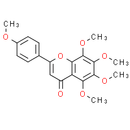Description
Tangeretin (Tangeritin), a flavonoid from citrus fruit peels, has been proven to play an important role in anti-inflammatory responses and neuroprotective effects in several disease models, and is a Notch-1 inhibitor.
Product information
CAS Number: 481-53-8
Molecular Weight: 372.37
Formula: C20H20O7
Synonym:
Tangeritin
NSC53909
NSC618905
Related CAS Number:
2174-59-6 (5-Demethylnobiletin)
1620970-95-7 (5-AcTMF)
Chemical Name: 5, 6, 7, 8-tetramethoxy-2-(4-methoxyphenyl)-4H-chromen-4-one
Smiles: COC1C=CC(=CC=1)C1=CC(=O)C2=C(O1)C(OC)=C(OC)C(OC)=C2OC
InChiKey: ULSUXBXHSYSGDT-UHFFFAOYSA-N
InChi: InChI=1S/C20H20O7/c1-22-12-8-6-11(7-9-12)14-10-13(21)15-16(23-2)18(24-3)20(26-5)19(25-4)17(15)27-14/h6-10H,1-5H3
Technical Data
Appearance: Solid Power
Purity: ≥98% (or refer to the Certificate of Analysis)
Solubility: DMSO: 8 mg/mL(21.48 mM). Water: Insoluble.
Shipping Condition: Shipped under ambient temperature as non-hazardous chemical or refer to Certificate of Analysis
Storage Condition: Dry, dark and -20 oC for 1 year or refer to the Certificate of Analysis.
Shelf Life: ≥12 months if stored properly.
Stock Solution Storage: 0 - 4 oC for 1 month or refer to the Certificate of Analysis.
Drug Formulation: To be determined
HS Tariff Code: 382200
How to use
In Vitro:
Tangeretin is a polymethoxylated flavonoid concentrated in the peel of citrus fruits. Recent studies have shown that tangeretin exhibits anti-proliferative, anti-invasive, anti-metastatic, and antioxidant activities. Tangeretin at 2.7 μM induces apoptosis in human promyelocytic leukaemia HL-60 cells, whereas the flavone showed no cytotoxicity against human peripheral blood mononuclear cells (PBMCs). Further study shows that tangeretin at 50 μM exerts its growth-inhibitory effects through modulation of the activities of several key G1 regulatory proteins such as Cdk2 and Cdk4, and mediates the increase of Cdk inhibitors p21 and p27. Pretreatment with tangeretin inhibites IL-1beta-induced p38 MAPK, JNK, and AKT phosphorylation and the downstream activation of NF-kappaB in human lung epithelial carcinoma cells (A549) and and human non-small cell lung carcinoma cells (H1299).
References:
- Chen KH, et al. Biochem Pharmacol, 2007, 73(2), 215-227.
- Pan MH, et al. Carcinogenesis, 2002, 23(10), 1677-1684.
- Hirano T, et al. Br J Cancer, 1995, 72(6), 1380-1388.
Products are for research use only. Not for human use.
Payment & Security
Your payment information is processed securely. We do not store credit card details nor have access to your credit card information.


